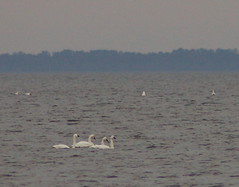Perhaps I came off a bit over zealous yesterday, in my post about teaching students to memorize. I’m not suggesting that because we carry laptops and net-connected mobile phones around with us, we (educators) can all go home. Far from it. I think that our jobs just got a whole lot richer and more interesting, as several readers implied in their comments yesterday. What I am suggesting is that the education that many of us were brought up in assumed a scarcity of information, and therefore, relied heavily on our brain’s ability to memorize. It was a central part of education. ..and for the past several years, we, in the U.S., have come to over-emphasize memorization rather than reshape education to reflect a much more abundant information environment — because memorized information is easier and cheaper to test.
I agree that having to constantly look up facts in the workplace will not be productive. However, I suspect that those facts that are crucial to one’s work will be learned fairly quickly, as we will come to memorize what we need to in the work place. It’s why I’m suggesting different kinds of questions and/or different kinds of assignments that are more workplace-like — more relevant. These assignments might be designed to require students to memorize some listing of information in order to perform.
Ditto to Ewan Macintosh, who’s original post (Sparknotes straight to mobile) sparked this conversation. I agree about the value of Sparksnotes and Cliffnotes to help students answer those questions of meaning from their teachers. However, if those teacher questions asked for conversations among students, rather than just answers, then each student becomes personally responsible to the class for their answers, and the answers that they share become building blocks for greater knowledge — and I suspect that Sparknotes would not be sufficient for this. Does this make sense?
I agree that we need a balance, but that balance needs to be wrapped around today’s information landscape. ..and I fear that too many teachers and curriculum developers are shaping their work around the way they’ve always done it, more than the shape of today’s information.
Another commenter suggests that the best defense against getting the wrong information from your research is a proper context, some prior general knowledge of the topic — and I agree. But memorization is not the only way or even the best way to do this. Many years ago, I helped my daughter study for a test about the American Civil War. We talked about it, using the textbook as our base. I read through the chapter and we talked about why the south and the north fought the war, what their advantages and disadvantages were, and what they would each gain by winning. At the end, she knew about that war, could talk about it, and could answer good questions about that period of U.S. history. Yet she made a 52 on the test, because she couldn’t name the dates of the major battles of that war — and this was a GOOD teacher. I suspect though, that should was probably better prepared to conduct further research and further self-teaching about the Civil War than many of her classmates who had memorized dates.
Finally, Steve Ladan, an educator in the Philippines, asks about what they should be teaching where students do not have convenient access to computers and the Internet. That’s a big question, bigger than me. But I continue to believe that the answer to all of this lies in our notions of what it means to be literate today, the skills required to use information to accomplish goals (my definition). Certainly those skills include the ability to read, to independently perform basic calculations, and write a coherent paragraph. But it also means the ability to:
- skillfully and resourcefully find the information that is appropriate to your task,
- to decode the information from one format to another,
- to evaluate that information to determine its value, and
- to organize the information in ways that add value.
It means being able to process information when it comes in numbers, but also when it comes as images, sound, or video. All digital information is processable.
It means not merely being able to write a coherent paragraph, but how to express your knowledge and ideas compellingly, using not only the written word but the digitized and networked word, and images, and sound, and video.
I believe that these are all basic skills, and that teaching them does not only happen in front of a computer. The most important parts happen during conversations in the classroom. For instance, when a student asks a question in class, we (teachers) might say, “How should we go about finding the answer to that question,” rather than simply answering it — teaching students to learn to rely on their own resourcefulness. When a student answers a question or turns in a report, the teacher might ask, “How do you know that that is true?” The student who expects that kind of question becomes responsible for the quality of the research, not just the paper he turns in.
I suspect that parts of this can happen without a computer in every student’s hand. But they need some level of access to digital networked information. Do you have a computer in your classroom? How do you invite that technology into your conversations? Do you have Internet in your classroom? How do you connect it to your classroom instruction? What is the availability of cyber cafes? How might you introduce a learning culture into them, or the local cyber cafes into the culture of your school? I don’t know the answers to these questions, because I’m not there. But I think that you have to use what you have and believe that the rest will come — faster than may seem logical today. It’s a problem that we face in much of the U.S. as well — though it’s not because we can’t afford it.
It’s because we’re not looking forward, and I guess that’s what I’m suggesting that we all do.
Image Citation:
Reavel, “Look Forward.” Reavel’s Photostream. 14 Oct 2006. 3 Jan 2007 <http://flickr.com/photos/reavel/269287145/>.
Technorati Tags: warlick digital technology education literacy










 My father worked as an accountant and efficiency researcher for the trucking company (after five years as a school teacher). The job was about as information-based as you could get back then, though he spent a good deal of his time operating an adding machine. I remember that one of them actually had a crank.
My father worked as an accountant and efficiency researcher for the trucking company (after five years as a school teacher). The job was about as information-based as you could get back then, though he spent a good deal of his time operating an adding machine. I remember that one of them actually had a crank.